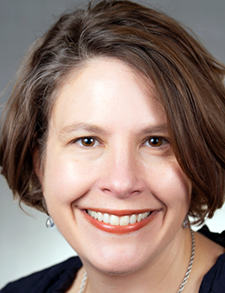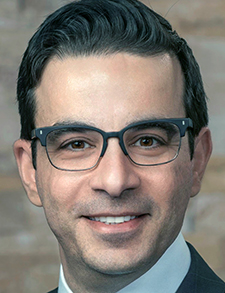
When she joined the faculty of the University of Texas Southwestern in Dallas as a junior member in 2011, Christiana Renner, MD received mentorship in areas such as clinical care and leadership.

Dr. Renner
But on the academic side, little was available. There was, she felt, no one available to help guide her through the process of publishing scholarly articles.
“For my first four, five, six years as faculty at UT Southwestern I did not have anyone that I would identify as someone who would mentor me in the academic side,” she said. “So I had zero output for my first six years as far as publications. I did lots of curriculum development, I did national talks, but I didn’t have any publications.”
With publications a central—although hardly exclusive—element in getting promoted through the ranks in many tracks at academic medical centers, that poses a barrier. Academic hospital medicine faculty who have been involved in and done research on promotions in their field say that an early understanding of promotion criteria, quality mentorship, identifying a passion, and pursuing it energetically are all vital ingredients to successfully navigating the promotion process.
Since her first few years, Dr. Renner has connected with a new senior member of the faculty to work on getting research published and is now an associate professor. But it was a struggle—and for many hospitalists, it continues to be, it seems.
A study in 2021 on which Dr. Renner worked found that, among the 25 top internal medicine programs, 30% of the academic hospital-medicine faculty were at the instructor or lecturer rank, 58% were assistant professors, and just 9% were at the associate-professor and 3% at the full-professor rank. In academic cardiology, by comparison, 28% were full professors, and 23% were associate professors.
For junior faculty, the publication output—which the researchers called the “principal currency” for being promoted, often more salient than factors such as committee involvement and quality improvement projects—was almost non-existent. The median number of publications for both instructors and assistant professors was 0.0. For associate professors, the median was nine, and for full professors, it was 38.
The H-index (a metric on the impact of published research), the number of years post-residency, completion of chief residency, and graduating from a top-25 medical school were all factors associated with promotion, the researchers found.
Researchers have also found that the amount of published works varies considerably even among full professors in hospital medicine. The top quintile of the 128 of these professors identified in the study had a median of 176 publications and an H-index of 37, while those in the bottom quintile had a median of 0 publications. None of the 49 who were clinical professors was in the top quintile, researchers found.
Dr. Renner said the emphasis on publications for promotions has increased in recent years at her center, and promotion from assistant to associate professor now typically requires three to four publications, with one as the first author. From associate to full professor may require around 10 publications.
“That’s actually gotten more stringent over the years,” she said. “It used to be that you could just do curriculum development, you could be highly involved in committees and give a couple of talks at national conferences, and you were good. But now they kind of want to see something tangible that shows in a search of PubMed.” The shift to a more quantifiable metric helps remove some of the subjectivity from the process, she said.
At other centers, there doesn’t always seem to be quite as much emphasis on publication. In her research, she found, for instance, that full professors in hospital medicine at the University of California, San Francisco—where the concept of hospital medicine was born—had between 0 and 12 publications.
With a bottom-heavy academic presence in hospital medicine, mentors on scholarly publications can be hard to come by, she said.
“There are not a lot of people who have the ability to mentor people so that they get these articles published,” she said.
Ann-Marie Tantoco, MD, assistant professor at the Northwestern University Feinberg School of Medicine in Chicago, where she has helped develop a resource for acquiring external letters of recommendation for promotion, said the mentoring process at her center is quite good. Still, academic publishing is one of the weaker areas.
“In Northwestern’s division of hospital medicine, I think we are good at introducing early faculty to various career interests and more senior peers, but we don’t have a structured program to help develop publishing and writing skills,” she said.
At Northwestern, assistant professors applying for promotion to associate professor typically need several peer-reviewed publications, with “a few” being first author, she said, along with regional recognition, showing excellence in a certain field, and other requirements. The promotion process is “very stressful” and is not always straightforward, she said.
“They have requirements of what they would want for a promotion but sometimes it can be very hard to quantify,” she said.

Dr. Barkoudah
Ebrahim Barkoudah, MD, MPH, MBA, regional chief medical and quality officer and system chief of hospital medicine at Baystate Health in Springfield, Mass. said that at his center, there are slides on each pathway for promotions available at annual reviews so that potential candidates know the milestones and guidelines for each rank. The number of publications, abstracts presented, national talks, and mentees you’ve taken under your wing all factor into a composite score that is considered when you’re up for a promotion at his center, he said.
Structured mentoring, with regularly scheduled meetings that include agendas and tasks in between those meetings, is an essential part of the process of being promoted, he said. It should be a “set time where you turn off your computer and have a one-to-one,” he said.
“The goal here is to make sure we all understand the structure,” Dr. Barkoudah said. “It’s not a 30-minute just to check a box off. We need to make it meaningful. We need to have psychological safety for the mentee to react and be part of it and be able to say, ‘This is not where I want to go. I have another interest; I need your help with that.’”
At any given time, he mentors 10 to 15 people, he said.
While mentors are often assigned at a center, junior faculty should seek out mentors they think are suited to their interests, and Dr. Barkoudah suggests they consider mentors beyond hospital medicine.
“As someone passionate about hospital medicine as a field, I’ve been fortunate enough to be mentored by cardiologists and clinical trialists,” he said. “That expanded my horizon, and gave me more edge on how I think about the clinical research or leadership dilemmas. You can reach out to cardiology, you can reach out to critical care, you can reach out to nephrology.”
It’s an important decision, he said.
Dr. Barkoudah said, “My mentor—Mark A. Pfeffer, MD, PhD—one time said, ‘Your mentor is like your mom or your dad. And you have a chance to choose, so choose wisely.’”

Dr. Rao
Deepti Rao, MD, professor in the hospital medicine division and vice division chief for faculty affairs at the University of New Mexico in Albuquerque, said senior faculty can help those they mentor move through the ranks by getting to know the faculty in their division so they are in a position to match up junior faculty with the right projects.
“Even if you’re not sitting in on the reviews, get to know the faculty in your division. When you hear about things that come up, think about junior faculty for opportunities,” she said. “Opportunities come up all the time so consider who might benefit from this opportunity, who seems to have an interest in the area, and then encourage them to apply.”
For junior faculty, the “number one” thing they can do for their career is to find their passion—an area in which they have an interest and would like to grow.
“The people I’ve seen who do really well within a year or two of starting their job, understand themselves enough to know what they love and what they want to put their time and energy into and then associate themselves with other people and activities aligned with those same interests,” she said.
For those who aren’t sure of their interests, she said to start by signing up for activities and projects and going from there.
“You need to get out there,” she said. “I think it’s just a process.”
Dr. Tantoco said an early focus and involvement are extremely valuable.
“If you know your interest, get involved in projects or interest groups regarding those subjects to get to know more people, get involved in either quality initiative projects or groups that can help get things on your CV and help you get to know more people,” she said. “The more you do, the more people will know you, and the more you’ll be able to get on your CV, and the more experience you’ll have.”
Dr. Renner said helping junior faculty advance through the ranks is an important part of a successful program.
“If you can retain good people, you’re going to improve your reputation. If it’s always 60% of your people are new people, you can’t really build a program,” she said. At UT Southwestern, she said, “If we continue to grow, maybe at some point, a hospitalist will be a chair of medicine here—something that was inconceivable when I started.”
Dr. Rao said success with the promotion process can have wide-reaching effects.
“Once you have more and more senior faculty, that’s just helpful for everyone in the department and the division. So those people can mentor junior faculty, they take positions in the university and your group as a whole gets more visible in the health sciences center.”
Read: Pathway to Promotion: Practical Tips and Tools for Early to Mid-career Physicians
External Recommendation Letters Made Easier
When a junior faculty member in pediatric hospital medicine is looking to get promoted from assistant professor to associate professor, or from associate to full professor, they might have just about everything lined up—peer-reviewed publications, committee involvement, talks at big conferences, plenty of colleagues at their center to vouch for their credentials. But then they might look around and wonder who will write an external letter of recommendation.
Ann-Marie Tantoco, MD, assistant professor of medicine and pediatrics at the Northwestern University Feinberg School of Medicine in Chicago and some of her colleagues saw this as a potential stumbling block for some applicants and have put together a tool to help: a pool of potential external letter-writers who could be matched up with faculty hoping to be promoted. The resource grew out of her involvement with the SHM’s Pediatrics Special Interest Group, in collaboration with the American Academy of Pediatrics and the Academic Pediatric Association.
“It can be difficult to find people to write these external letters,” she said. External letters of recommendation—which are a requirement for promotion at most major academic medical centers—can be a particularly tricky requirement because they need to come from someone outside the center where an applicant works. So it has to be someone familiar with the work of the applicant, but it needs to be an “arm’s length” familiarity—the mentor with whom you’ve worked for 10 years, for example, is not a candidate.
The resource Dr. Tantoco and her colleagues have developed is a list of volunteer letter-writers—all pediatric hospitalists with the rank of associate or full professor—that includes their areas of expertise, contact information, and the number of letters they are willing to write each year. There is also a list of pediatric hospitalists who need external letters.
“We have a group of people who look at both of those lists and when someone requests names, we look at our lists of volunteer letter-writers and match up based on the interest and the rank they want to apply to,” she said.
So far, 104 people have volunteered to write letters, and 69 have requested names of letter writers. Because the promotion process is lengthy, it is not yet known how many of those applicants have been successful.
Dr. Tantoco said it is meant to make a complicated and stressful process a bit easier.
“All of us were looking at how we could help those who were trying to get promoted.”
Tom Collins is a medical writer in South Florida who has written about everything from lethal infections to thorny ethical dilemmas, runaway tumors to tornado-chasing doctors. He gathers health news from around the globe and lives in West Palm Beach.